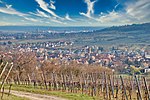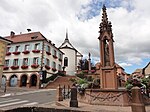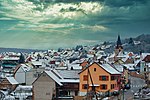Église Saint-Étienne de Rosheim
1788 establishments in FranceBas-Rhin building and structure stubsChurches completed in 1788Churches in Bas-RhinFrench church stubs ... and 1 more
Monuments historiques of Bas-Rhin

Église Saint-Étienne de Rosheim is a church in Rosheim, Bas-Rhin, Alsace, France. Originally built in the 13th century, it was last built in 1788. It became a registered Monument historique in 1990.
Excerpt from the Wikipedia article Église Saint-Étienne de Rosheim (License: CC BY-SA 3.0, Authors, Images).Église Saint-Étienne de Rosheim
Place Saint-Étienne, Molsheim
Geographical coordinates (GPS) Address Nearby Places Show on map
Geographical coordinates (GPS)
| Latitude | Longitude |
|---|---|
| N 48.495555555556 ° | E 7.4666666666667 ° |
Address
Place Saint-Étienne 1
67560 Molsheim
Grand Est, France
Open on Google Maps









